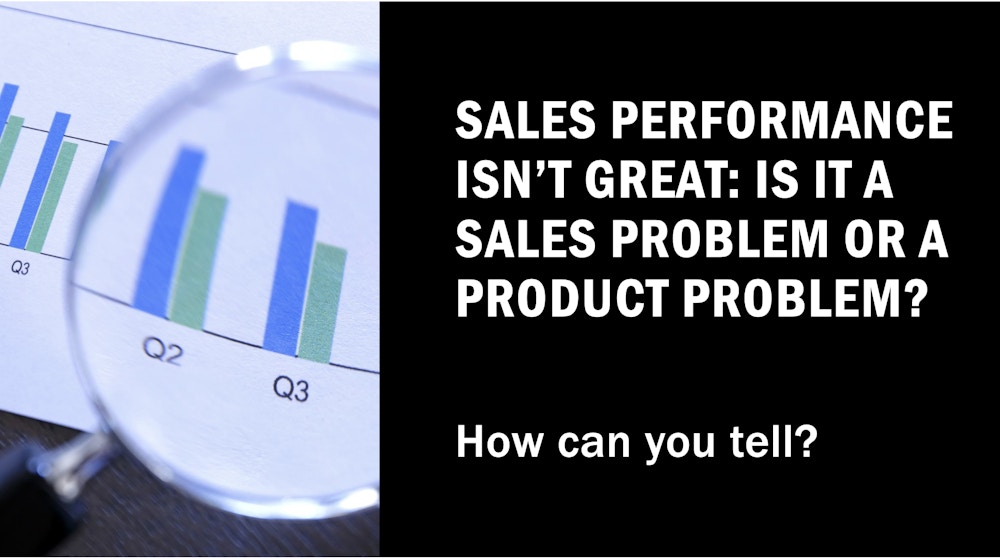Here is the scenario: revenue growth isn’t what you’d hope it to be. Maybe you’re a SaaS start-up and sales aren’t growing the way you’d hope. Maybe you’re a B2B company and sales have slowed down or stalled at a modest level. Maybe you’ve launched a new product, and it’s just not gaining the revenue traction you would have hoped. Is it a sales problem or is it a product problem?
By sales problem, I mean – is it a problem with simply not having the right sales leadership, sales reps, sales structure, and/or sales investment? By product problem, I mean – is there not product/market fit, does the product not really solve a broad problem, is there really no market for the solution? Usually, sales teams in such situations are likely to blame product (or marketing). And product teams are likely to blame the sales team. Which is it, and how can you tell?
In my experience, most of the time, CEOs will say it’s a sales problem. It’s quite often that CEOs will declare the solution to fixing lackluster revenue performance is a need for better sales leadership, organization, accountability, management, reps, resourcing, etc. Sales is an easy target and can seem like an easier fix. To be fair, sometimes it is a sales problem.
It’s rather infrequent that I will hear from CEOs that it’s a product problem. I can’t recall if I’ve ever heard a CEO tell me: we built a product that doesn’t solve a real problem for anyone in particular. This is a much harder admission to make though is a far more common cause than is usually identified.
It’s rather infrequent that I will hear from CEOs that it’s a product problem. I can’t recall if I’ve ever heard a CEO tell me: we built a product that doesn’t solve a real problem for anyone in particular.
So how can you tell if it’s a sales or product problem? Let me provide a few metrics to look for that will lean the answer towards one or the other. Let me be perfectly clear that no individual metric is the perfect indicator, but these are directional clues that might lean in one direction or another.
3 Signs It’s More Likely To Be A Product Problem
High Customer Logo Churn. If sales is selling the product to customers, but customers aren’t sticking with the product, then there are two general possibilities – either sales is selling it to the wrong customer segment or the product isn’t providing enough value to the customer to keep. While both are possible, I believe this is more likely indicative of a product problem as I give credit to customers to properly qualify themselves before purchasing a product. High logo churn can often be overlooked as an issue in the early days of a company because upsell can lead to 100%+ net revenue retention regardless – but it’s still a red flag of possible product/market fit issues.
High Sales Rep Churn. If you’ve hired a lot of reps, they aren’t productive, and they churn – this also leans towards a product problem in my book. Companies that have great product and product/market fit are easier to sell. Everything is easier for the sales rep – leads come in, demos are easier to schedule, pipeline is easier to close, commissions are easier to gain. The inverse is true as well, and sales reps can feel that every time they get on a call with a prospect. Therefore, high sales rep churn can often and ironically point more towards a product problem than a sales problem.
Weak New Logo Velocity. Sometimes companies do have customers, and there is high retention of those customers, but new logo velocity is hard to come by. It’s easy to point to the high retaining customers to validate the value of the product – which is true for those customers. But, the weakness in new logos can be because the product has value to only a very limited market, and so ultimately there is product/market fit issue especially from a market perspective. The product simply doesn’t solve a big enough problem for a broad enough market.
3 Signs It’s More Likely To Be A Sales Problem
Strong Qualified Lead Volume, Weak Close Rates. Again, let’s give credit to prospects for being selective about what vendors they spend time with, who they fill out a lead-gen form with, who they sit on a demo with, and who they give their valuable time with on sales calls to. A consistent volume of well-qualified leads (not raw or early leads) is a strong signal for product-market fit and a broad pain point being addressed. Therefore, if close rates are weak in that type of lead environment, then it’s more than reasonable to question the capabilities of the sales team.
Strong Performance Next To Weak Performance. This can take shape in a few different ways. There are a couple of strong sales reps performing well above quota, but several who are not. The channel sales partners are selling the product well, but direct sales team is not. Sales are strong in certain geographic segments, industry verticals, customer segments or certain use cases, but not in others. The point is there is validation of product/market value and velocity somewhere within the sales organization, and it’s about aligning the right resources and methodologies against the lowest friction points in the market.
Perpetually Exaggerating Sales Pipeline. It is ultimately the job of the sales team to properly project and weight the sales pipeline. If the sales team always expects to sell more than it does, and that persists by a wide margin, then that’s foundationally a sales issue. After all, product doesn’t own the sales pipeline, sales does. Perpetual exaggeration in the sales pipeline usually is a sign of lack of accountability, process, and detail in the sales organization – all of which are important ingredients for a high-performing sales team. It’s hard for sales teams to get sales right if they can’t get the pipeline right first.
Again, none of these metrics stand-alone as the clear diagnosis of the problem. But, if you see them together in the context of a single company, it might help to point you in the direction of whether poor sales performance is in fact a sales problem or a product problem.
[Do you agree or disagree with the message behind some of these metrics? Would you propose other metrics as markers for a sales or product problem? Any other questions or ideas for blog posts – let me know at asklarry@volitioncapital.com.]

